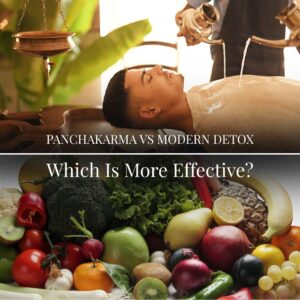Classical Ayurvedic Treatment for Arthritis at Vaidyaratnam Vrindavan Ayurveda Chikitsalayam combines Panchakarma, dietary guidance, lifestyle changes, and herbal remedies.
VVAC operates on the principles of Ayurveda, and all Panchakarma treatments are based on the Ashtanga Hridaya and other classical Ayurvedic texts. Hence, our well-experienced doctors focus on the root cause of Arthritis rather than just instant relief from the symptoms.
According to Ayurveda, Arthritis is caused by a Vata imbalance in the body, leading to pain, stiffness, swelling, inflammation, and reduced mobility.
Read on to see how Vaidyaratnam Vrindavan Ayurveda Chikitsalayam uses Panchakarma treatments for Osteoarthritis (Sandhigata Vata) and Rheumatoid Arthritis (Aamavata).
Types of Arthritis
Predominantly, Arthritis is caused by an imbalance in the Vata dosha, which causes dryness, inflammation, and degeneration in the joints. Additionally, the accumulation of toxins (amas) plays an important role in worsening the condition. Speaking about types of Arthritis, there are mainly three kinds –
1. Osteoarthritis (Sandhigata Vata)
As per Ayurveda, Osteoarthritis occurs due to an imbalance of Vata dosha, which is known to reduce joint lubrication and degeneration of cartilage in and around joints. Ageing is another cause of Arthritis that increases dryness in the joints. Excessive physical strain, nutritional deficiencies (Calcium and Vitamin D), consuming Vata-aggravating foods, obesity, poor digestion, and a sedentary lifestyle are major contributors to this health issue.
The common symptoms of Osteoarthritis include Sandhishoola (joint pain), Stambha (stiffness), Shotha (swelling), joint cracking sound, reduced flexibility and mobility, frequent weakness, increased pain during cold days, and deformity (in severe cases).
2. Amavata (Rheumatoid Arthritis)
Aamavata, as the name suggests, is caused by ama dosha and vitiated Vata dosha. In Amavata, there are symptoms of poor digestion, constipation, fever, diarrhoea, lethargy, and more. Rheumatoid Arthritis is an autoimmune disorder where the body’s immune system attacks the joints instead of fighting foreign elements. It leads to chronic inflammation, pain, and extreme stiffness. Unlike Osteoarthritis, which happens due to wear and tear of joints, RA is a systemic condition that aggravates pain and deterioration in multiple joints and organs, too.
Weak digestion leads to the accumulation of Amas (toxins) in the body, which gets deposited in the joints that triggers inflammation and stiffness. Also, if left untreated, it can cause joint deformities and severe mobility restrictions.
3. Vatarakta (Gouty Arthritis)
Vatarakta can be closely correlated with gout in modern medicine. Gout is caused by an imbalance in uric acid metabolism, leading to the accumulation of urate crystals in joints. In Ayurveda, Vatarakta is a disorder that arises due to the vitiation of Vata dosha, which subsequently affects Rakta dhatu (blood tissue). The pain experienced in Vatarakta is described as Vrischik Damsha Vata Vedana, where pain resembles a scorpion bite.
Like gout, Vatarakta typically begins in the small joints of the hands and feet, particularly in the first metatarso-phalangeal joint. Vatarakta is classified into two types: Uttana (superficial) and Gambhira (deep-seated), which can also be seen as its progressive stages.
In Uttana Vatarakta, symptoms include redness, itching, small eruptions, and skin discoloration. In Gambhira Vatarakta, the condition progresses to intense pain, stiffness, and potential joint deformity. Similarly, in advanced stages of gout, urate crystals accumulate to form tophi at the affected joints.
Click on the image below and take our 5-minute quiz to know the dosha imbalance in your body.

Ayurvedic Treatment for Arthritis at Vaidyaratnam Vrindavan Ayurveda Chikitsalayam
Vaidyaratnam Vrindavan Ayurveda Chikitsalayam sits in the lap of nature, surrounded by 500 acres of lush green forest cover. For classical Ayurvedic treatment for Arthritis, VVAC should be your chosen wellness center, as our expert doctors follow the Ashtavaidyan texts. This ensures authentic ayurvedic treatment for arthritis protocols that restore balance in the body.
At VVAC, Himachal Pradesh following is the list of all the classical Panchakarma treatments performed by highly skilled and well-experienced therapists under the guidance of senior Ayurvedic doctors.
Classical Ayurvedic Treatment for Arthritis (Osteoarthritis)
| Panchakarma Treatment at VVAC | Procedure and its Benefits |
| Januvasti (Oil Therapy for Knee) | In this treatment, warm medicated oil is retained in a dough-ring over the knee joints for a specific duration that reduces pain, relieves stiffness, strengthens knee cartilage, and lubricates joints. |
| Kashaya Vasthi (Herbal Decoction Enema) | Known for detoxification, pacification of Vata dosha, and reduction of joint inflammation, Kashaya Vasthi involves use of medicated herbal decoction to cleanse toxins from the colon. |
| Thaila Vasthi (Oil Enema) | Our therapists lubricate the rectum using medicated oil that nourishes the internal body, relieves dryness and pain too. |
| Prushta Vasthi (Oil Therapy for Back) | Using a special dough ring, warm medicated Vaidyaratnam oil is retained over the upper or lower back that improves spinal flexibility and reduces inflammation. |
| Katee Vasthi (Oil Therapy for Lower Back) | Specifically pooled over the lower back, the medicated oil is retained in the section for a specific duration to ease lumbar pain, reduce stiffness, and nourish spinal discs. |
| Choorna Pinda Sweda (Herbal Powder Poultice) | In this Ayurvedic treatment for Arthritis, swelling and stiffness are reduced by placing a warm herbal powder-filled poultice over the affected area and massaging it over the joints and muscles. At VVAC, the preparation of the treatments is freshly done at in-house Kashayapura, which is the heart of our wellness centre. |
| Pichu (Oil-Soaked Cotton Application) | In this Panchakarma treatment at VVAC, our therapists soak the cotton pads in the medicated oils and place them directly over the affected joints for deep penetration and nourishment. |
| Ksheeradhara (Milk & Herbal Decoction Therapy) | This classical Ayurvedic treatment for Arthritis aims to reduce dryness, suppress inflammation, and nourish tissues. Hence, warm medicated milk is continuously poured over the body or joints. |
| Pizhichil (Oil Bath Therapy) | When lukewarm medicated oil is poured over the body in rhythmic movements that strengthen muscles, relieve joint stiffness, and improve blood flow. |
| Jaloukavacharana (Leech Therapy) | Yes, you read that right, LEECHES! Medicinal leeches are applied to extract impure blood from inflamed and affected areas, which reduces swelling and detoxifies blood. |
Classical Ayurvedic Treatment for Arthritis (Rheumatoid)
A study sponsored by the World Health Organisation, the results of which are improved grip strength, walking time, reduced joint pain and swollen joints. Hence, the higher efficacy of authentic ayurvedic treatments improves the condition of RA among the health seekers suffering.
| Panchakarma Treatment at VVAC for Arthritis | Procedure and its Benefits |
| Nadee Swedam (Herbal Steam Therapy) | According to this Panchakarma treatment, medicated steam is directed onto painful joints that relax those muscles and reduce stiffness in that area. |
| Dhanya Pinda Sweda (Grain-Based Poultice Therapy) | Special grains and Vaidyaratnam medicinal powders, herbs are prepared in a warm bolus that is applied to the joints. Known to improve circulation, strengthen muscles, and relieve joint pain. |
| Lepana (Herbal Paste Application) | With an objective to reduce inflammation and soothe pain, our therapists apply a thick medicated paste over the affected joints. |
| Upanaha (Herbal Poultice Bandage) | Upanaha is an ayurvedic treatment for Arthritis, where a herbal paste, which is freshly prepared in our in-house Kashayapura, is wrapped around the inflamed area to ease joint stiffness and pain. |
| Dhanyamla Dhara (Herbal Fermented Decoction Pouring) | Medicated oil, a liquid, is continuously poured over the body and joints that relieve body pain. |
| Choorna Pinda Sweda | For the reduction of swelling and inflammation in the joints, warm boluses filled with dry herbal powders sourced from Vaidyaratnam are massaged over them. Medicated boluses are made from scratch and never reused at VVAC. |
| Valuka Sweda (Sand Bolus Therapy) | Sand-filled boluses are warmed and directly applied over joints for therapeutic heat. This relieves pain and stiffness from the joints, which improves flexibility. |
| Virechana (Purgation Therapy) | Through herbal purgatives, excess pitta and accumulated amas (toxins) from,m the body are eliminated. Not only does it balance doshas, but it also detoxifies the body deeply. |
Kashaya Vasthi, Dhanyamla Pinda Sweda, Rakthamokshana, and Thaila Vasthi are some additional classical Ayurvedic treatments of Arthritis offered at VVAC.

Yoga Asanas for Arthritis in Ayurveda
At Vaidyaratnam Vrindavan Ayurveda Chikitsalayam, Yoga and Meditation are one of the four pillars of the Ayurvedic treatment for Arthritis. Hence, our dedicated team understands that yoga plays a crucial role in the management of this ailment.
At VVAC, there are prescribed regular yoga sessions that aid in the treatment process and support Ayurvedic healing. Also, each yoga session is focused on improving joint mobility, strength, and flexibility. All of the treatments are customised and led by well-trained yoga experts.
| Yoga Asanas for Arthritis | Benefits for Osteoarthritis | Benefits for Rheumatoid Arthritis |
| Vrikshasana (Tree Pose) | Improves joint stability and balance, strengthens leg muscles, and reduces stiffness. | Enhances body coordination, promotes flexibility, and reduces fatigue. |
| Bhujangasana (Cobra Pose) | Strengthens the spine, reduces lower back stiffness, and enhances mobility. | Improves blood circulation, reduces inflammation, and helps with joint flexibility. |
| Setu Bandhasana (Bridge Pose) | Strengthens hip and knee joints, reduces pain, and enhances joint lubrication. | Detoxifies the body, eases stiffness, and strengthens the lower back. |
| Tadasana (Mountain Pose) | Aligns posture, improves spinal flexibility, and reduces joint pressure. | Improves blood flow, reduces morning stiffness, and enhances energy levels. |
| Trikonasana (Triangle Pose) | Strengthens knee joints, relieves stiffness, and improves flexibility. | Increases joint mobility, enhances circulation, and helps in detoxification. |
| Makarasana (Crocodile Pose) | Relieves tension in knee and hip joints, supports cartilage health. | Soothes joint pain, relaxes muscles, and reduces inflammation. |
| Veerabhadrasana (Warrior Pose) | Enhances leg strength, reduces joint pain, and improves posture. | Builds muscle endurance, reduces stress, and increases joint flexibility. |
| Baddha Konasana (Butterfly Pose) | Improves hip and knee mobility, prevents cartilage degeneration. | Relieves joint stiffness, detoxifies the body, and enhances flexibility. |
| Ardha Matsyendrasana (Half Spinal Twist) | Strengthens the spine, enhances flexibility, and supports joint lubrication. | Improves digestion, detoxifies the body, and relieves stiffness in joints. |
| Shavasana (Corpse Pose) | Promotes relaxation, reduces pain perception, and relieves stress. | Helps in overall healing, reduces inflammation, and enhances mental calmness. |

Follow VVAC’s Daily Schedule of the health seekers to know about our structured and Ayurvedic Dinacharya that promotes holistic wellness in the lap of nature.
Physiotherapy for Arthritis at VVAC by ReLiva
At VVAC, physiotherapy sessions by ReLiva help ease arthritis pain and improve movement. Experts guide you through simple exercises, joint mobility drills, and muscle-strengthening routines. They also use manual therapy and electrotherapy for faster recovery.
At Vaidyaratnam Vrindavan Ayurveda Chikitsalayam, ReLiva Physiotherapy offers a holistic and integrated approach to managing Osteoarthritis by combining Ayurvedic relief with modern physiotherapy through expert care.
- Electrotherapy for Pain Relief – According to Electrotherapy, there are three types of treatments like hot packs (relax stiff muscles and increase circulation), Ultrasound (reduce joint inflammation), and TENS (Transcutaneous Electrical Nerve Stimulation, which is a non-invasive method to relieve peripheral joint pain).
- Exercise Therapy for Joint Strengthening – VVAC has well-trained and well-experienced physiotherapists by ReLiva, who guide you through targeted movement routines that restore mobility and prevent joint degeneration. Some of the treatments are Isometric Strengthening, Concentric Strengthening, and Knee Mobilization (enhancement of flexibility and reduction in stiffness).
Also, these sessions work hand-in-hand with Ayurvedic treatments, making healing more effective. With personalized care in a peaceful, natural setting, you’ll feel stronger, move better, and enjoy a pain-free life.
Physiotherapy for Rheumatoid Arthritis at VVAC by ReLiva plays an essential role in the integrated care of health seekers with this ailment. Additionally, in the acute phase of RA, the first line of treatment includes hot pack therapy, which promotes blood circulation around the inflamed joints.
Therapeutic Exercise Protocol
After the inflammation is managed, a personalised exercise plan is introduced to improve joint mobility and function:
- Range of Motion (ROM) Exercises – ROM therapy gently mobilises joints and prevents stiffness with improved flexibility.
- Strengthening Exercises – It focuses on supporting muscles around the joint area. Additionally, our physiotherapists perform it with minimal strain to avoid flare-ups in future.
- Gripping Exercises – As the name suggests, gripping exercises improve hand functions and finger strength. Some of the activities that come under gripping are holding objects or writing.
Wax Therapy (Paraffin Therapy)
A deeply soothing treatment that reduces joint pain and improves mobility, especially in small joints like fingers and wrists. There are two ways of applying wax: that are pouring method and the dripping method. Also, the purpose of this therapy is to soften the stiff tissues and promote healing in the joints.
Herbal Remedies for Arthritis Treatment in Ayurveda
According to the results of a study in the USA, it was found that alternative and natural remedies are being used to target Arthritis pain and inflammation. The following are some of the herbs that a health seeker suffering from Arthritis must include in their diet.
- Shallaki (Boswellia Serrata): Helps in cartilage repair and reduces joint pain.
- Ashwagandha (Withania Somnifera): Strengthens bones, muscles, and reduces stiffness
- Dashmool (Ten Root Herb Mix): VVAC offers this herb mix that reduces swelling and removes toxins from the body
- Eranda (Castor Oil): A health seeker can apply the castor oil on the joints directly and massage which lubricates the area
- Nirgundi (Vitex Negundo): Application of warm nirgundi oil reduces swelling and relieves pain
- Harida (Turmeric): Turmeric has curcumin, which acts as a natural anti-inflammatory agent
In addition to these herbs, some others, such as Guduchi, Punarnava, Guggulu, are also more.
Lifestyle Modifications for Arthritis Pain Management
Rheumatoid Arthritis is no less than a monster in life if left untreated. Besides, taking classical Ayurvedic treatment for Arthritis, altering lifestyle is essential. Since Osteoarthritis and RA lead to painful inflammation, health seekers need regular follow-ups and modification of their lifestyle.
1. Diet and Nutrition
- Eat warm, freshly cooked meals that are easy to digest.
- Avoid Vata-aggravating foods like processed, cold, and dry foods.
- Include anti-inflammatory spices like turmeric, ginger, and garlic.
- Consume calcium-rich foods like sesame seeds, almonds, and leafy greens.
- Drink herbal decoctions like Dashmool Kwath and Guduchi tea.
2. Daily Routine (Dinacharya)
- Wake up early and follow a structured daily routine.
- Practice self-massage (Abhyanga) with warm herbal oils like Mahanarayan or Dhanwantharam oil.
- Take a warm water bath to relieve stiffness.
- Avoid overexertion and follow a balanced activity-rest schedule.
3. Physical Activity & Yoga
- Engage in gentle exercises and yoga to maintain joint flexibility.
- Practice joint-friendly asanas like Tadasana, Trikonasana, and Bhujangasana.
- Avoid excessive weight-bearing activities and prolonged standing.
4. Stress Management
- Practice meditation and pranayama to reduce stress, which worsens arthritis.
- Follow a positive and mindful lifestyle to maintain emotional well-being.
5. Sleep and Rest
- Ensure 7-8 hours of quality sleep for proper healing.
- Avoid late-night activities and excessive screen time before bed.
Why Choose VVAC?
If you are suffering from this ailment and need immediate professional medical yet natural help, VVAC should be your first choice towards healing and wellness. But WHY?
- North India’s Largest NABH-Accredited Ayurveda Centre – Specialising in classical Keraliya Ayurvedic treatments for Arthritis.
- Expert Ayurvedic Doctors & Therapists – Offering customised treatment plans for Osteoarthritis and Rheumatoid Arthritis.
- Authentic Panchakarma Treatments – Based on Ashtavaidyan classical texts, ensuring deep-rooted healing.
- Serene Natural Location – Located on the Shivalik Hilltop, surrounded by 500 acres of lush green forest, just 50 minutes from Chandigarh.
- Comprehensive Healing Approach – Includes in-house Gaushala, organic farming, and sattvic meals for holistic wellness.
- Advanced Physiotherapy & Rehabilitation – Personalised sessions to improve mobility, flexibility, and joint strength.
- A Retreat for Mind & Body – Experience Ayurveda, Yoga, and Nature for a pain-free and balanced life.
- VVAC is empanelled with CGHS, CAPF, Haryana Government, and private health insurance companies that offer reimbursed and cashless classical Panchakarma treatments.
So, when are you calling 7901778899 and booking yourself a slot for Ayurvedic treatment for Arthritis?





